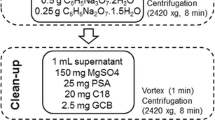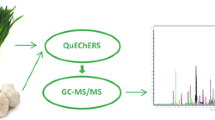Abstract
An analytical method for the simultaneous determination of residues of five insecticides and two fungicides in cabbage was developed and validated. Pesticide residues were extracted from the samples using QuEChERS extraction and the analysis was performed by liquid chromatography triple quadrupole mass spectrometry (LC-MS/MS). The performance of the method was investigated in terms of accuracy, precision, linearity, limit of detection (LOD), and limit of quantification (LOQ). The average recoveries ranged from 80 to 110 % with RSDr ≤ 16 % for all the analytes at four fortification levels of 0.01, 0.05, 0.10, and 0.20 mg/kg. The LOD values ranged from 0.001 to 0.003 mg/kg, and the LOQ for all the analytes was set at 0.01 mg/kg. The linearity was very good and coefficient of determination was ≥ 0.997 for all the analytes when matrix-matched calibration standards were used. Matrix effect was estimated and it was found prominent for cabbage with cypermethrin and deltamethrin (+49 and +97 %, respectively). The method was applied very satisfactorily for the residue analysis of 132 fresh cabbage samples collected from different market places in Thessaloniki, Greece. Among the analyzed samples, 41 (31 % of the total no. of samples) had pesticide residues, of which, two had multiple pesticide residues and 39 had a single pesticide residue. Only one sample was found contaminated with deltamethrin at a level above the European Union maximum residue levels (EU-MRLs). Variability of pesticide residues originated from the samples of cabbage purchased from different market places of Thessaloniki in Greece were also estimated in this study. The estimated variability factors ranged from 1.00 to 6.75 and the average VFs was 5.00.

Similar content being viewed by others
References
Advisory Committee on Pesticides (ACP) (1997) Unit to unit variation of pesticide residues in fruit and vegetables (York, UK: Advisory Committee on Pesticides, PSD)
Ambrus A (2006) Variability of pesticide residues in crop units. Pest Manag Sci 62:693–714
Anastassiades M, Lehotay SJ, Stajnbaher D, Schenck FJ (2003) Fast and easy multiresidue method employing acetonitrile extraction/partitioning and “dispersive solid-phase extraction” for the determination of pesticide residues in produce. J AOAC Int 86:412–431
Andersson A (2000) Comparison of pesticide residues in composite samples and in individual units: the Swedish approach to sampling. Food Addit Contam 17(7):547–550
Board for the authorisation of plant protection products and biocides (2014) Evaluation Manual for the authorisation of plant protection products and biocides according to Regulation (EC) No 1107/2009. EU part; Plant protection products. Chapter 5 Residues; risk to consumers, version 2.0
Caldas E, Jardim A, Ambrus A, Souza LC (2006) Variability of organophosphorus insecticide residues in large size crops grown in commercial farms in Brazil. Food Addit Contam 23:148–158
Earl M, Kaethner M, Uihlein M (2000) Unit to unit variation of pesticide residues—options for acute dietary risk assessment. Food Addit Contam 17:83–89
EURACHEM (1998) The fitness for purpose of analytical methods.www.eurachem.com
European commission (2005) EU pesticide residue MRLs. regulation no. 396/2005. http://ec.europa.eu/sanco_pesticides/public/index.cfm
European commission (2013) Method validation and quality control procedures for pesticides residues analysis in food & feed. Document no. SANCO/12571/2013
FAO/WHO (2005) Report of the joint meeting of the FAO panel of experts on pesticide residues in food and the environment and the WHO core assessment group on pesticide residues. FAO Plant Production and protection paper 183
FAO/WHO (1999) Pesticide residues in Food 1999, report of the joint meeting of the FAO panel of experts on pesticide residues in food and the environment and the WHO core assessment group on pesticide residues. FAO Plant Production and protection paper, 153
European Food Safety Authority (EFSA) (2005) Opinion of the scientific panel on plant health, plant protection products and their residues on a request from the commission related to the appropriate variability factor (s) to be used for acute dietary exposure assessment of pesticide residues in fruit and vegetables. EFSA J 177:1–61
Fernández Moreno JL, Garrido Frenich A, Plaza Bolaños P, Martínez Vidal JL (2008) Multiresidue method for the analysis of more than 140 pesticide residues in fruits and vegetables by gas chromatography coupled to triple quadrupole mass spectrometry. J Mass Spectrom 43(9):1235–54. doi:10.1002/jms.1400
Fujita M, Yajima T, Iijima K, Satoh K (2012a) Effect of sampling size on the determination of accurate pesticide residue levels in Japanese agricultural commodities. J Agric Food Chem 60:4457–4464
Fujita M, Yajima T, Iijima K, Satoh K (2012b) Comparison of the variability in the levels of pesticide residue observed in Japanese cabbage and grape units. J Agric Food Chem 60:1516–1521
Gilbert-Lopez B, Juan Garcia-Reyes F, Lozano A, Fernandez-Alba AR, Molina-Diaz A (2010) Large-scale pesticide testing in olives by liquid chromatography–electrospray tandem mass spectrometry using two sample preparation methods based on matrix solid-phase dispersion and QuEChERS. J Chromatogr A 1217:6022–6035
Hajslova J, Holadova K, Kocourek V, Poustka J, Godula M, Cuhra P, Kempny M (1998) Matrix-induced effects: a critical point in the gas chromatographic analysis of pesticide residues. J Chromatogr A 800:283–295
Hajslova J, Zrostlikova J (2003) Matrix effects in (ultra) trace analysis of pesticide residues in food and biotic matrices. J Chromatogr A 1000(1–2):181–197
Hans GJM, Ruud van Dam CJ, Odile MS (2003) Determination of polar organophosphorus pesticides in vegetables and fruits using liquid chromatography with tandem mass spectrometry: selection of extraction solvent. J Chromatogr A 1015:119–127
Harris C (1998) Unit to unit variability of pesticide residues in celery, plums and kiwi fruit, Report by the Pesticides Safety Directorate, York
Harris CA, Davis TJ (1998) Unit to unit variation of pesticide residues in celery, plums and kiwi fruit. Pesticide Safety Directorate, 1–62
Harris CA, Mashall JR, Warren SFP, Crossley SJ (2000) Summary report of the international conference on pesticide residues variability and acute dietary risk assessment. Food Addit Contam 17(7):481–485
Heimstra M, Kok AD (2007) Comprehensive multi-residue method for the target analysis of pesticides in crops using liquid chromatography–tandem mass spectrometry. J Chromatogr A 1154:3–25
Hill ARC, Reynolds SL (2002) Unit-to-unit variability of pesticide residues in fruit and vegetables. Food Addit Contam 19(8):733–747
Jansson C, Pihlström T, Österdahl BG, Markides KE (2004) A new multi-residue method for analysis of pesticide residues in fruit and vegetables using liquid chromatography with tandem mass spectrometric detection. J Chromatogr A 1023:93–104
Kaethner M (2002) Determination of residue variability in table and wine grapes after a tank-mix application of anilinopyrimidine, triazole, pyrethroid, organophosphate, and di-carboximide crop protection products – France/Germany 2000 to 2001, Summary Report by the ECPA Residues Expert Group, 2002, BASF DocID 2002/1007077
Lehotay SJ, Kyung AS, Kwon H, Koesukwiwat U, Fu W, Mastovska K, Hoh E, Leepipatpiboon N (2010) Comparison of QuEChERS sample preparation methods for the analysis of pesticide residues in fruits and vegetables. J Chromatogr A 1217:2548–2560
Lehotay SJ, De Kok A, Hiemstra M, Van BP (2005) Validation of a fast and easy method for the determination of residues from 229 pesticides in fruits and vegetables using gas and liquid chromatography and mass spectrometric detection. J AOAC Int 88(2):595–614
Ministry of Rural Development and Food of Hellenic Republic (2012). Available on: http://wwww.minagric.gr/syspest/SYSPEST_CROPS_eng.aspx.
Organic Facts (2015) Health benefits of cabbage. https://www.organicfacts.net/…benefits/…/health-benefits-of-cabbage.htm…
Pang GF, Fan CL, Liu YM, Cao YZ, Zhang JJ, Li XM, Li ZY, Wu YP, Guo TT (2006) Determination of residues of 446 pesticides in fruits and vegetables by three-cartridge solid-phase extraction-gas chromatography–mass spectrometry and liquid chromatography-tandem mass spectrometry. J AOAC Int 89(3):740–71
PSD (Pesticides Safety Directorate) (1998) Unit to unit variability of pesticide residues in celery, plums and kiwi fruit (York, UK: Pesticides Safety Directorate)
Prodhan MDH, Papadakis EN, Papadopoulou-Mourkidou E (2015) Analysis of pesticide residues in melon using QuEChERS extraction and liquid chromatography triple quadrupole mass spectrometry. Int J Environ Anal Chem 95(13):1219–1229. doi:10.1080/03067319.2015.1025227
Romero-GonzAlez R, Garrido Frenich A, Martínez Vidal JL (2008) Multiresidue method for fast determination of pesticides in fruit juices by ultra performance liquid chromatography coupled to tandem mass spectrometry. Talanta 76(1):211–25. doi:10.1016/j.talanta.2008.02.041
Takatori S, Yamamoto H, Fukui N, Yamaguchi S, Kitagawa Y, Kakimoto Y, Osakada M, Okihashi M, Kajimura K, Obana H (2013) Validation study on a rapid multi-residue method for determination of pesticide residues in vegetables and fruits by LC-MS/MS. J Food Hyg Safety sci 54(3):237–249
Singh B, Kar A, Mandal K, Kumar R, Sahoo SK (2012) Development and validation of QuEChERS method for estimation of chlorantraniliprole residue in vegetables. J Food Sci 77(12):T208–15. doi:10.1111/j.1750-3841.2012.02801.x
Yu-feng S, Xiao LU, Feng-shan REN (2011) Variability of pesticide residues in vegetables from the marketplaces in Jinan city. Agric Sci China 10(10):1646–1652
Acknowledgments
The principal author is grateful to the State Scholarship Foundation (IKY), Greece, for their financial support to pursue his PhD. The authors are thankful to Kotopoulou Athina, kintzikoglou Katherina, and Tsampoula Aggeliki in the Pesticide Science Laboratory of AUTH for their cooperation during the present study.
Author information
Authors and Affiliations
Corresponding author
Ethics declarations
Funding
Not applicable
Conflict of Interest
M. D. H. Prodhan declares that he has no conflict of interest. Emmanouil-N. Papadakis declares that he has no conflict of interest. Euphemia Papadopoulou-Mourkidou declares that she has no conflict of interest.
Ethical Approval
The manuscript has not been published previously and has not been submitted to another journal for simultaneous consideration. This article does not contain any studies with human or animal subjects.
Informed Consent
Not applicable
Rights and permissions
About this article
Cite this article
Prodhan, M.D.H., Papadakis, EN. & Papadopoulou-Mourkidou, E. Analysis of Pesticide Residues and Their Variability in Cabbage Using QuEChERS Extraction in Combination with LC-MS/MS. Food Anal. Methods 9, 3470–3478 (2016). https://doi.org/10.1007/s12161-016-0537-z
Received:
Accepted:
Published:
Issue Date:
DOI: https://doi.org/10.1007/s12161-016-0537-z




